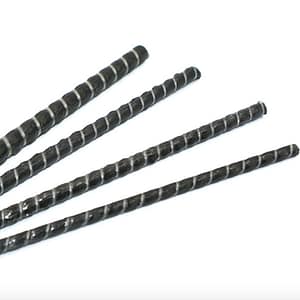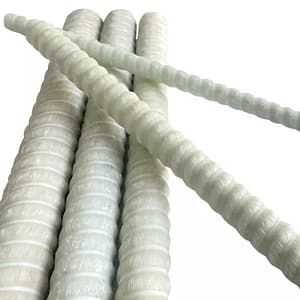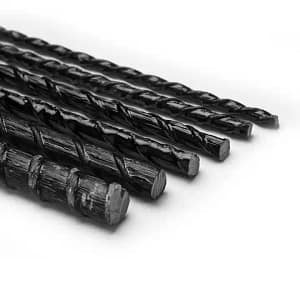What is fiberglass rebar?
Fiberglass rebar is a kind of new advanced material, widely applied in structural strengthening, structural reinforcement, concrete repair, underground tunnel, highways, bridge, airport, dock, station, water projects, etc. Because of its anti-corrosion, it can be applied in sewage disposal facilities, chemical factory, electrolysis bath, manhole cover, marine facilities. Fiberglass can be the solution to many existing projects problems, not like corrosive steel rebar, it brings the new opportunity for construction development.
Advantages of Fiberglass Rebar
- high strength, 20% stronger than steel rebar with the same diameter, meanwhile with good anti-fatigue property.
- light weight, only 1/4 weight of steel rebar with the same diameter, its density is between 1.5 and 1.9g/cm3.
- anti-corrosive, no matter alkali or acid, the fiberglass rebar can retain its mechanical properties in harsh environment.
- good integration, fiberglass rebar has similar coefficient of thermal expansion with concrete, so it has better bonding strength with concrete structures.
- low thermal and electricity conductivity.
- Non-magnetic.
- Easy handling. The fiberglass rebar can be customized for different diameter and length as per project requirement. It can be tied with non-metal strap.
- Fiberglass is cheaper than steel rebar in the long run, considering the maintenance cost.
Fiberglass Rebar Properties
| Diameter | mm | 3 | 6 | 9 | 12 | 16 | 19 | 22 | 25 | 32 | |
| Weight | g/m | 13 | 52 | 118 | 209 | 372 | 524 | 702 | 908 | 1487 | |
| Glass Fiber Content | % | 70 | 70 | 70 | 70 | 70 | 70 | 70 | 70 | 70 | ASTM D2584 |
| Specific Gravity | g/cm3 | 1.85 | 1.85 | 1.85 | 1.85 | 1.85 | 1.85 | 1.85 | 1.85 | 1.85 | ASTM D792 |
| Tensile Strength | MPa | 980 | 825 | 760 | 690 | 655 | 620 | 586 | 550 | 480 | ASTM D3916 |
| Tensile Modulus | GPa | 35-41 | 35-41 | 35-41 | 35-41 | 35-41 | 35-41 | 35-41 | 35-41 | 35-41 | |
| Strain | % | 1.8 | 1.8 | 1.8 | 1.8 | 1.8 | 1.8 | 1.8 | 1.8 | 1.8 | |
| Compressive Strength | MPa | 790 | 750 | 710 | 630 | 630 | 630 | 610 | 610 | 610 | |
| Flexural Strength | MPa | 850 | 810 | 750 | 680 | 680 | 660 | 660 | 640 | 640 | ASTM D4476 |
| Flexural Modulus | GPa | 35-41 | 35-41 | 35-41 | 35-41 | 35-41 | 35-41 | 35-41 | 35-41 | 35-41 | |
| Shear Strength | MPa | 160 | 160 | 160 | 160 | 160 | 160 | 160 | 160 | 160 | ASTM D3914 |
| LongitudinalCTE | 10-6/℃ | 9-10 | 9-10 | 9-10 | 9-10 | 9-10 | 9-10 | 9-10 | 9-10 | 9-10 | ASTM D696 |
| TransverseCTE | 10-6/℃ | 20-21 | 20-21 | 20-21 | 20-21 | 20-21 | 20-21 | 20-21 | 20-21 | 20-21 | ASTM D696 |
| Moisture Absorption | % | 0.3-0.5 | 0.3-0.5 | 0.3-0.5 | 0.3-0.5 | 0.3-0.5 | 0.3-0.5 | 0.3-0.5 | 0.3-0.5 | 0.3-0.5 | ASTM D570 |
Production Process
The production process of fiberglass rebar is called pultrusion or die extrusion. The glass rovings firstly saturated in the resin (epoxy or vinyl ester based) pool, then squeezed in bar shape meanwhile the extra resin is removed, after that, the fiber-resin matrix is spooled with specific thread to help it keep the shape and form the ribs, finally it enters the cure oven. When the rebar lines go out of the oven, it can be rolled or cut in certain length.

Applications
The range of applications of fiberglass rebar is very extensive.
- Chemical plants
- Sewage disposal plants
- Road construction
- Bridge construction
- Sea piles
- Sea walls
- Port deck
The most important property of fiberglass rebar is corrosion resistant, which will save huge maintenance cost and promote the safeness in the long run. The fiberglass rebar is also popularly used in structural reinforcement, because it can improve the seismic resistant property.


Any question or need more information?



